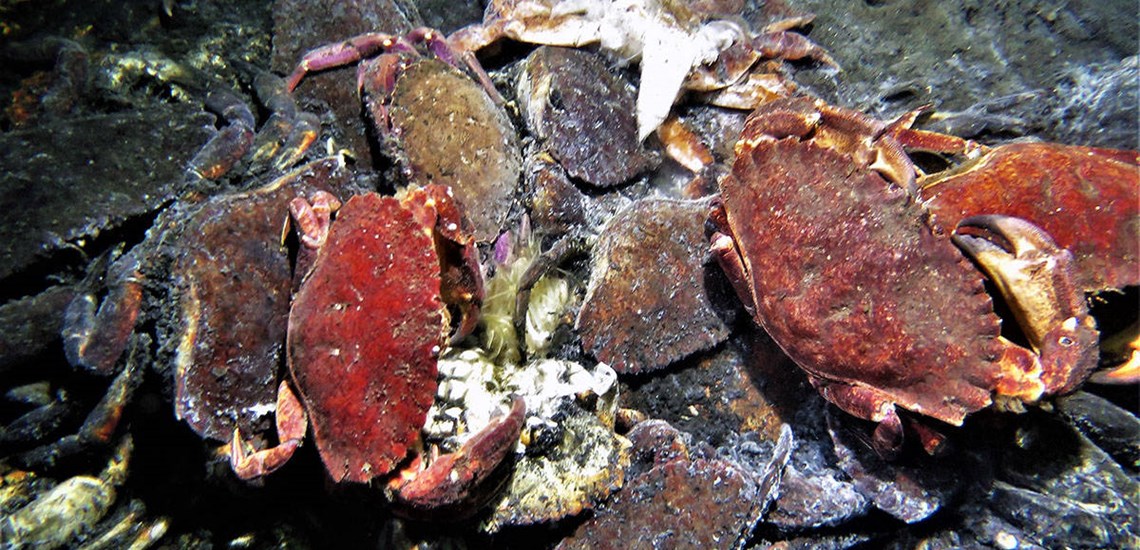Divers in a British Columbia town fear that dumped tyres are threatening the existence of local crabs.
Crabs Under Threat from Tyres in British Columbia
The dive community in Chemainus has become aware of the damage and devastation that can occur from disrespecting the environment.
Chemainus (BC) residents Kathleen Fenner and Gord Bell, along with retyred marine biologist Doug Biffard of Duncan and other divers, know the local waters well. Some of their discoveries are alarming.
“We have a beautiful piece of ocean in our area that needs respect, not garbage dumped in it,” noted Fenner.
Back in 2017, the Courier published an article about diving on the sunken barges in Chemainus Bay in which Fenner was quoted as saying, “sadly, there is some old wood, pipe and four tyres each about eight feet tall also in the area.”
A year ago, Fenner took a closer look at the tyres.
“It was worse than anticipated,” said Fenner. “The tyres trap crabs, indiscriminately killing them. The crabs crawl in and cannot get out… It is such a waste of Red Rock, Dungeness and other crab species.
“I had no idea they were killing crabs. We can survive without crab in our diet but by allowing these tyres to remain down there we create havoc on the balance of nature.”
Fenner and Biffard submitted a report to the Department of Fisheries and Oceans (DFO) this spring, requesting help to remove the tyres. “We need a commercial diver to get these out,” Fenner suggested.
Their Chemainus Bay Marine Debris Project in March 2020 was very thorough, citing the background of the four large barges and associated rigging that sank at the entrance to Chemainus Bay in 2012. The barges were brought in as part of the development of the Chemainus Quay and Marina, a project that eventually failed.
The report laid out the details of how the tyres attract and trap both Red Rock, the predominant species in the tyres, and Dungeness crabs. Dead and decayed crabs in all stages from lively to moribund, recently dead and partially decomposed were observed.
That was an indication of how crabs are constantly attracted to the tyres and then become trapped inside and perish.
The report provided a practical solution for commercial salvage and recycling.
The total budget to clear the tyres is estimated at $13,000, including $10,000 for dive salvage and loading for transport and another $3,000 for trucking and recycling.
North Cowichan Mayor Al Siebring was supportive of the tyre removal, but he stated that North Cowichan does not have the funds to take on the project. However, at Siebring’s request, North Cowichan’s Environmental Specialist Dave Preikshot has been working with them to motivate the DFO to act.
Attempts have been made to greatly reduce the costs associated with the project by getting Tire Stewardship BC, a non-profit society that manages B.C.’s tyre recycling programme, to take responsibility for the tyre disposal. Volunteer boats could also be supplied so only a commercial diver would need to be paid.
But the executive director of Tire Stewardship BC advised they do not deal with Off the Road tyres. They require the Ministry of Environment and Climate Change to add them to their mandate, but it is not a priority, they stated.
Properly disposing of the tyres is a huge challenge, since there is no means for recycling them on the Island and they would have to be shipped elsewhere.
“It appears that the tyre removal and disposal will require the support of many if it is to be realised,” summed up Fenner.
“I am afraid if the public aren’t concerned, we’ll never get these tyres out. We need approval to have them dumped on land and someone to pick them up and dispose of them properly. We are working with Tire Stewardship BC and others to have this accomplished.”
Source: Saanich News




















